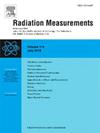Experimental evaluation of radon detector performance under controlled conditions: Statistical assessment and calibration strategy
IF 2.2
3区 物理与天体物理
Q2 NUCLEAR SCIENCE & TECHNOLOGY
引用次数: 0
Abstract
This work presents a quantitative evaluation of radon detectors under controlled environmental conditions using the RDN-SENUBIO-UPV radon chamber. The study emphasizes the statistical assessment of spatial radon distribution and the comparative sensitivity analysis of multiple detector models against a high-precision AlphaGUARD monitor. A comprehensive methodology is developed, involving the calculation of relative errors, analysis of variance (ANOVA), and normality testing (Kolmogorov–Smirnov), to assess measurement consistency. Moreover, individual correction factors are derived and validated through repeated experimental trials to improve the accuracy of time-dependent measurements. The proposed calibration protocol enhances measurement reliability by accounting for detector-specific response dynamics and environmental transients. The results support the implementation of reproducible correction schemes and contribute to improved quality assurance practices in radon monitoring. The approach provides a rigorous statistical framework applicable to other radiation detection systems.
受控条件下氡探测器性能的实验评价:统计评估和校准策略
这项工作提出了使用rnd - senubio - upv氡室在受控环境条件下对氡探测器的定量评估。该研究强调了空间氡分布的统计评估和多个探测器模型对高精度AlphaGUARD监测仪的比较灵敏度分析。开发了一种综合的方法,包括相对误差的计算,方差分析(ANOVA)和正态性检验(Kolmogorov-Smirnov),以评估测量一致性。此外,通过反复实验,推导并验证了个体校正因子,以提高时变测量的精度。提出的校准方案通过考虑探测器特定的响应动力学和环境瞬态来提高测量可靠性。结果支持可重复校正方案的实施,并有助于改进氡监测的质量保证做法。该方法提供了一个适用于其他辐射探测系统的严格统计框架。
本文章由计算机程序翻译,如有差异,请以英文原文为准。
求助全文
约1分钟内获得全文
求助全文
来源期刊

Radiation Measurements
工程技术-核科学技术
CiteScore
4.10
自引率
20.00%
发文量
116
审稿时长
48 days
期刊介绍:
The journal seeks to publish papers that present advances in the following areas: spontaneous and stimulated luminescence (including scintillating materials, thermoluminescence, and optically stimulated luminescence); electron spin resonance of natural and synthetic materials; the physics, design and performance of radiation measurements (including computational modelling such as electronic transport simulations); the novel basic aspects of radiation measurement in medical physics. Studies of energy-transfer phenomena, track physics and microdosimetry are also of interest to the journal.
Applications relevant to the journal, particularly where they present novel detection techniques, novel analytical approaches or novel materials, include: personal dosimetry (including dosimetric quantities, active/electronic and passive monitoring techniques for photon, neutron and charged-particle exposures); environmental dosimetry (including methodological advances and predictive models related to radon, but generally excluding local survey results of radon where the main aim is to establish the radiation risk to populations); cosmic and high-energy radiation measurements (including dosimetry, space radiation effects, and single event upsets); dosimetry-based archaeological and Quaternary dating; dosimetry-based approaches to thermochronometry; accident and retrospective dosimetry (including activation detectors), and dosimetry and measurements related to medical applications.
 求助内容:
求助内容: 应助结果提醒方式:
应助结果提醒方式:


